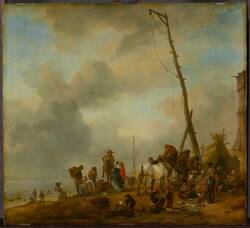The second room on our tour highlights Friedrich’s political paintings and his scenes of cemeteries and graveyards. Let’s start with probably his most outstanding view of a cemetery.
A large gate opens onto a cemetery with a mysterious, other-worldly atmosphere, bathed in moonlight and with patches of drifting fog. A man and woman are at the large stone gatepost on the left – yet they hesitate to enter. Their gaze is fixed on a point directly behind the entrance where a dark patch of ground indicates a freshly dug grave.
It seem likely the couple are standing in front of the grave of their child, who has just died. When Caspar David Friedrich painted this work in around 1825, he and his wife Caroline had just lost the second of their four children. Quite possibly, The Cemetery is a highly intimate personal memento.
But the scene also has a consoling element. It includes two other figures as well, painted so finely they seem hazy and indistinct: directly over the grave a torso with head and arms; and an angel with outspread arms at the height of the trees. A friend of Friedrich’s the artist saw the painting in his studio, and later described it in the words: “They think they can see their child rising from its grave, the shades of its ancestors moving towards it (...) and an angel of peace (...) floating over them and uniting them.”
Whether Friedrich intentionally left these ghostly figures as they are or simply never finished the painting remains unclear – but we do know the figures of the parents were inspired by an Old Master painting. Further to the right, you can see Philips Wouwerman’s Fishermen at the Beach with a couple standing close together in the centre. From Friedrich’s sketchbooks, we can tell this provided the original idea for the couple at the cemetery gate.
Further Media
- Location & Dating
- c. 1825
- Material & Technique
- Oil on canvas
- Dimenions
- 143 x 110 cm
- Museum
- Galerie Neue Meister
- Inventory number
- Gal.-Nr. 2197 B
